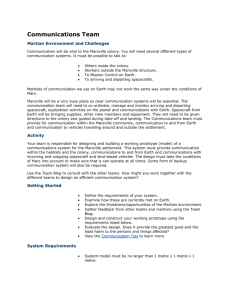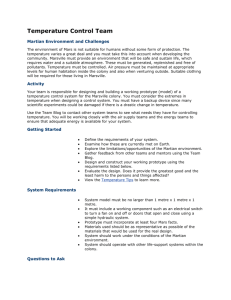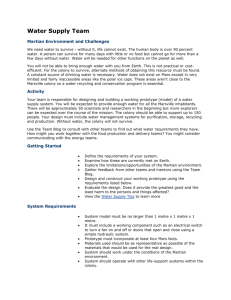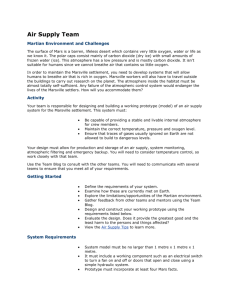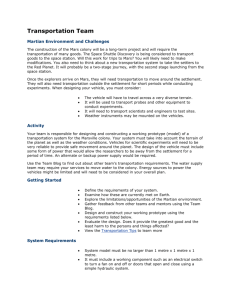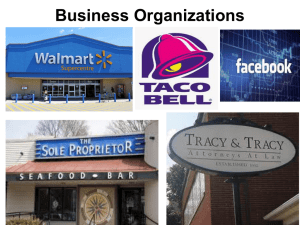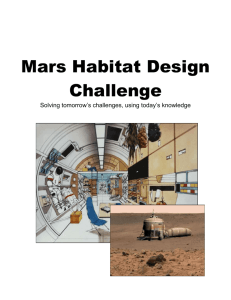Food Production and Delivery Team
advertisement
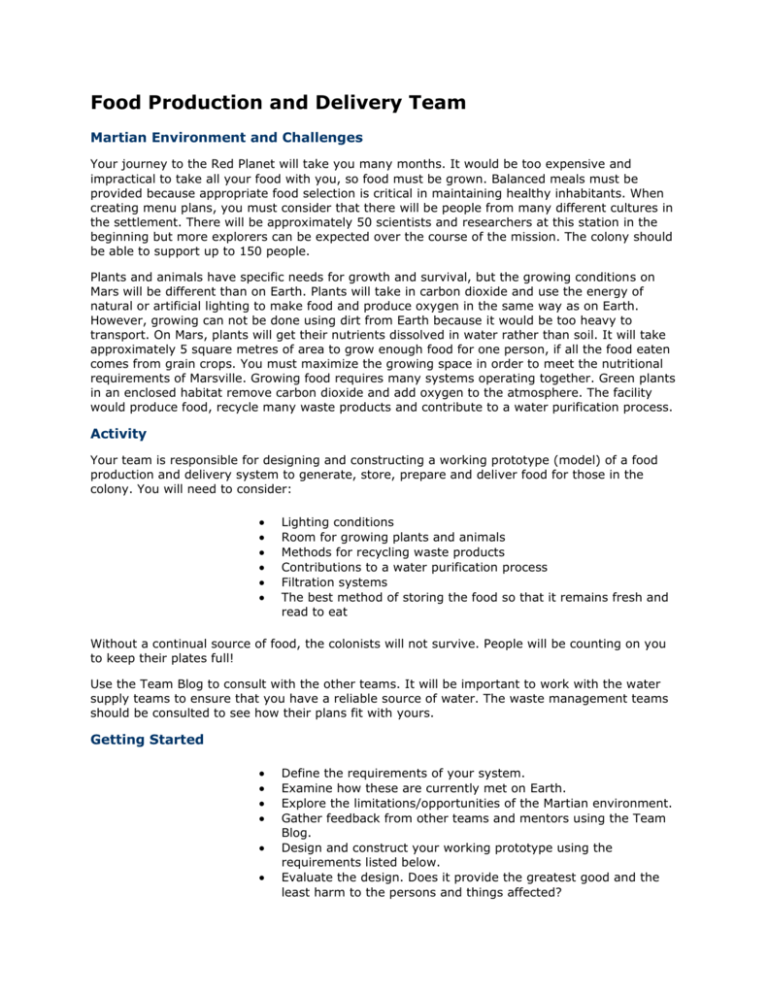
Food Production and Delivery Team Martian Environment and Challenges Your journey to the Red Planet will take you many months. It would be too expensive and impractical to take all your food with you, so food must be grown. Balanced meals must be provided because appropriate food selection is critical in maintaining healthy inhabitants. When creating menu plans, you must consider that there will be people from many different cultures in the settlement. There will be approximately 50 scientists and researchers at this station in the beginning but more explorers can be expected over the course of the mission. The colony should be able to support up to 150 people. Plants and animals have specific needs for growth and survival, but the growing conditions on Mars will be different than on Earth. Plants will take in carbon dioxide and use the energy of natural or artificial lighting to make food and produce oxygen in the same way as on Earth. However, growing can not be done using dirt from Earth because it would be too heavy to transport. On Mars, plants will get their nutrients dissolved in water rather than soil. It will take approximately 5 square metres of area to grow enough food for one person, if all the food eaten comes from grain crops. You must maximize the growing space in order to meet the nutritional requirements of Marsville. Growing food requires many systems operating together. Green plants in an enclosed habitat remove carbon dioxide and add oxygen to the atmosphere. The facility would produce food, recycle many waste products and contribute to a water purification process. Activity Your team is responsible for designing and constructing a working prototype (model) of a food production and delivery system to generate, store, prepare and deliver food for those in the colony. You will need to consider: Lighting conditions Room for growing plants and animals Methods for recycling waste products Contributions to a water purification process Filtration systems The best method of storing the food so that it remains fresh and read to eat Without a continual source of food, the colonists will not survive. People will be counting on you to keep their plates full! Use the Team Blog to consult with the other teams. It will be important to work with the water supply teams to ensure that you have a reliable source of water. The waste management teams should be consulted to see how their plans fit with yours. Getting Started Define the requirements of your system. Examine how these are currently met on Earth. Explore the limitations/opportunities of the Martian environment. Gather feedback from other teams and mentors using the Team Blog. Design and construct your working prototype using the requirements listed below. Evaluate the design. Does it provide the greatest good and the least harm to the persons and things affected? View the Food Tips to learn more. System model must be no larger than 1 metre x 1 metre x 1 metre. It must include a working component such as an electrical switch to turn a fan on and off or doors that open and close using a simple hydraulic system. Prototype must incorporate at least four Mars facts. Materials used should be as representative as possible of the materials that would be used for the real design. System should work under the conditions of the Martian environment. System should operate with other life-support systems within the colony. System Requirements Questions to Ask What are the four food groups as outlined in the Canada Food Guide? What are examples of foods in each group? Why is it necessary to have foods from each food group every day? Why will proper nutrition be so important on Mars? What sources of protein will be available on the colony? What other sources of protein could be used? How will water supply be controlled for the production of food? What types of energy would be suitable for growing food? Once the food has been grown and harvested, how will it be stored for long periods? What kinds of provisions need to be made for emergency situations? How will workers who have to leave the habitat get their food? What changes would you need to make to the food for these trips? What materials can you use to make prototypes of your system? What groups or agencies could you contact to get further information about your topic? Tips for Building Food Production and Delivery Systems Here are some ideas to help you learn more about your life-support system. Make sure you divide up the topics and share your findings on the Team Blog. Study Canada's Food Guide and start a daily log of food eaten every day. Determine if your are meeting the daily requirements for the essential vitamins and nutrients. Invite a public health nurse or dietitian to the class to talk about nutrition and Canada's Food Guide. Make a sample meal plan for three days, one week or two weeks following Canada's Food Guide. Are all of the necessary nutrients included? Consider what changes might be needed for a healthy diet. Use a spreadsheet program to compare the costs of the various meal plans. Come up with the least expensive but most nutritious menus for Earth and for Mars. Calculate the cost of feeding your habitat team for one week using one of the menu plans. Examine the types of food that have been eaten by astronauts over the history of the space program. Look at how food is preserved on the Space Shuttle Discovery and the International Space Station. How appropriate are these methods for Mars? Collect various foods packaged in different ways and discuss which foods could or could not be taken into space. Research to discover the favourite foods of the Canadian astronauts and the most common foods taken on the Space Shuttle Discovery by these astronauts. Conduct a survey of favourite foods for the habitat teams, CNM participants and mentors across Canada. Enter the information into a database program. Collect regional recipes or space food recipes from across Canada and compile these into a Space Recipe Book. Use a database and desktop publishing program for this activity. Experiment with different methods of food preservation and preparation for life on Mars. Develop a new space food for Mars and an advertising campaign to market this product across Canada. Take regional differences and food preferences into account Design a greenhouse or similar structure to grow your own food. What energy system would be available to give you the necessary conditions? How would this link with the water supply team? Grow vegetables such as carrots or lettuce using hydroponics. Invite a speaker to the class to discuss this method of growing food.
